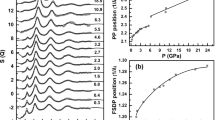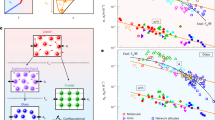Abstract
THE vitrification of phosphoric acids is relatively easy, a glass often being formed simply on cooling from the liquid melt. Special procedures, however, are required to crystallise these materials. The glass transition temperature, Tg, is the temperature above which there is relatively rapid molecular motion; below Tg translational motion of molecules is inhibited. In standard texts1 it is stated that the glass transition temperature of orthophosphoric acid, H3PO4, is −121 °C. The source of the determination is not always cited but it seems to be that of Kobeko et al.2 who determined Tg from measurements of the temperature dependence of the electrical conductivity of phosphoric acid. Although published almost 40 yr ago there does not seem to have been a more recent determination. We present here evidence from broad-line nuclear magnetic resonance (NMR) studies that the estimate of −121 °C for the glass transition temperature of orthophosphoric acid is wrong. A discussion of the nterpretation of the electrical conductivity of phosphoric acid would be in appropriate beyond observing that several different ionic or molecular processes may be responsible for the transfer of electrical charges. Thus, an unambiguous determination of a glass transition from such data may be far from straightforward.
This is a preview of subscription content, access via your institution
Access options
Subscribe to this journal
Receive 51 print issues and online access
$199.00 per year
only $3.90 per issue
Buy this article
- Purchase on Springer Link
- Instant access to full article PDF
Prices may be subject to local taxes which are calculated during checkout
Similar content being viewed by others
References
Toy, A. D. F., The Chemistry of Phosphorus, 482 (Pergamon, Oxford, 1975).
Kobeko, P. P., Kuvshinskii, E. V., and Shishkin, N. J., J. phys. Chem., Mosc., 9, 387 (1937).
Ellis, B., and McDonald, M. P., J. non-cryst. Solids, 1, 186 (1969).
Ellis, B., in Amorphous Materials (edit. by Douglas, R. W., and Ellis, B.), 357 (Wiley, New York, 1972).
Gee, G., Amorphous Materials (edit. by Douglas, R. W., and Ellis, B.), 115 (Wiley, New York, 1972).
Yates, M. J., thesis, Univ. Sheffield (1973).
Smith, R. J., thesis, Univ. Sheffield (1976).
Maklakov, A. I., and Pimenov, G. G., J. polym. Sci., U.S.S.R., 15, 123 (1973).
McCall, D. W., Acc. chem. Res., 4, 223 (1971).
Bondi, A., Physical Properties of Molecular Crystals, Liquids and Glasses, 379 (Wiley, New York, 1968).
Eisenberg, A., Farb, H., and Cool, L. G., J. polym. Sci., A-2, 4, 855 (1966).
Author information
Authors and Affiliations
Rights and permissions
About this article
Cite this article
ELLIS, B. The glass transition temperatures of phosphoric acids. Nature 263, 674–676 (1976). https://doi.org/10.1038/263674a0
Received:
Accepted:
Published:
Issue Date:
DOI: https://doi.org/10.1038/263674a0
Comments
By submitting a comment you agree to abide by our Terms and Community Guidelines. If you find something abusive or that does not comply with our terms or guidelines please flag it as inappropriate.



